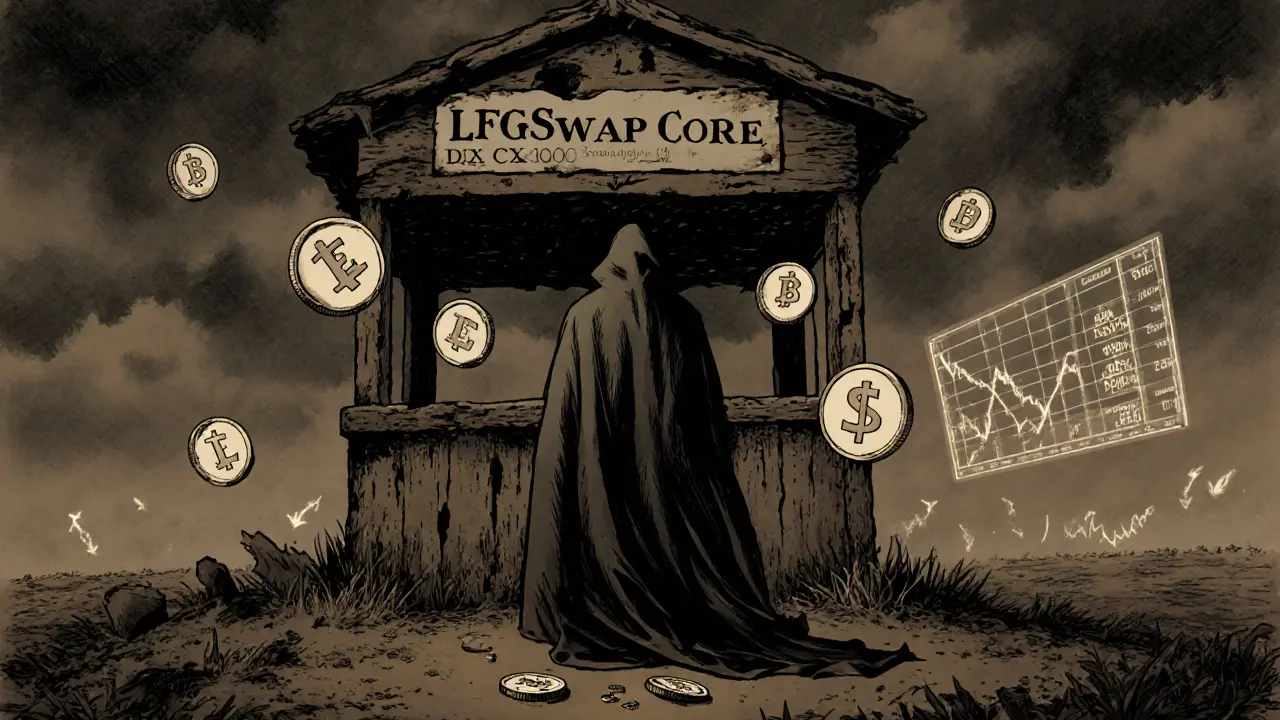LFGSwap Liquidity Risk Calculator
How much could you lose?
LFGSwap (Core) has lost 99.9% of its value since March 2023. This calculator shows potential losses based on the token's extreme volatility and low liquidity.
There are thousands of crypto exchanges out there. Most of them are either giant platforms like Binance or well-known DeFi swaps like Uniswap. Then there’s LFGSwap (Core) - a tiny, barely visible player that barely registers on the radar. If you’re wondering whether this is the next big thing or just another forgotten project, here’s the truth: LFGSwap (Core) isn’t a crypto exchange you’d use for serious trading. It’s a high-risk gamble with almost no infrastructure to back it up.
What Even Is LFGSwap (Core)?
LFGSwap (Core) is a decentralized exchange (DEX) launched in 2023. That means, unlike Binance or Coinbase, you don’t hand over your crypto to them. You trade directly from your wallet using smart contracts. Sounds good, right? But here’s the catch: it only supports three coins and four trading pairs. That’s not a feature - it’s a red flag. Compare that to Uniswap, which lists over 10,000 tokens. LFGSwap isn’t trying to compete. It’s barely trying to exist.
The whole platform revolves around one token: LFG. That’s the native coin. And it’s not doing well. At its peak in March 2023, LFG hit $0.102. Today, it’s trading around $0.0001. That’s a 99.9% drop. You read that right. Almost all value has vanished. The token has a max supply of 500 million, so technically, it’s deflationary. But deflation doesn’t help if no one wants to buy it.
Trading Volume? Barely There
Look at the numbers. On September 29, 2025, the 24-hour trading volume for LFG was around $398. That’s less than what a single trade on Uniswap does in five seconds. Crypto.com reported a slightly higher volume of $576, but even that’s tiny. Why the discrepancy? Because there’s no real liquidity. The price jumps around because a handful of people are moving it. That’s not a market - it’s a sandbox.
Some centralized exchanges like Bybit, Crypto.com, and MEXC list LFG. That sounds reassuring, but it’s misleading. They’re just listing a low-volume token. It doesn’t mean the DEX itself has traction. If you trade LFG on Bybit, you’re not using LFGSwap (Core). You’re using a centralized exchange trading a weird coin. The DEX? It’s basically empty.
Technical Indicators: A Mixed Bag
Some sites show technical signals that look promising. Bitget says LFG has 12 buy signals, 9 neutral, and 4 sell signals. The RSI is at 56 - neutral. The MACD shows a buy. The STOCH is at 78, which hints it might be overbought. On paper, it looks like a coin that could bounce. But technical analysis doesn’t work when there’s no volume. You can’t trust indicators on a token that trades less than $600 a day. It’s like checking the weather on a desert island - no one’s there to feel it.
Price predictions are all over the place. Digital Coin Price says LFG could hit $0.000986 by 2027. Bitscreener says it might spike to $0.1482. MEXC thinks it’ll crawl to $0.000022. These aren’t forecasts - they’re guesses. No analyst has access to real data. No team is publishing updates. No roadmap exists. Anyone claiming to know where LFG is headed is just making it up.

No Security Audits. No Transparency.
This is the biggest problem. You don’t know if the smart contracts are safe. There’s no public audit report. No bug bounty program. No multi-sig wallet details. No GitHub activity. No team members listed. Nothing. In DeFi, trust isn’t built on promises. It’s built on proof. LFGSwap (Core) offers zero proof.
Imagine handing your keys to a house you’ve never seen. You don’t know if the locks work. You don’t know if the owner is even real. That’s what using LFGSwap (Core) feels like. Even the most risky DeFi projects usually at least publish a basic audit. LFGSwap doesn’t even bother.
Who’s Using It? No One.
Successful DeFi projects live on Discord, Telegram, and Twitter. They post weekly updates. They answer questions. They run AMAs. LFGSwap (Core) has none of that. A quick search shows almost no active communities. No Reddit threads. No meaningful Twitter engagement. No YouTube tutorials. No Medium posts from the team. If a project this old has no community, it’s because no one cares.
DeFi isn’t just code. It’s culture. It’s trust built through transparency and communication. LFGSwap (Core) doesn’t have any of that. It’s a ghost town.

Why Does This Even Exist?
It’s possible LFGSwap (Core) was launched as a speculative experiment. Maybe a small group of developers wanted to test a DEX model with minimal resources. Maybe it was a pump-and-dump setup from the start. Either way, it’s not a platform designed for users - it’s a token designed for traders hoping to catch a quick rise.
It launched in 2023, right when DeFi was cooling down. Regulation tightened. Investors pulled back. New projects struggled to attract liquidity. LFGSwap didn’t stand out with better tech, lower fees, or unique features. It just showed up and disappeared.
Should You Trade on LFGSwap (Core)?
No - unless you’re okay with losing everything you put in.
Here’s the reality: you’re not trading on a reliable exchange. You’re gambling on a token that’s lost 99.9% of its value, has no community, no security audits, and no future roadmap. Even if you think you’re buying low, you’re really just buying into uncertainty.
There are better alternatives. If you want a DEX with real volume and security, use Uniswap or PancakeSwap. If you want to trade small-cap tokens, use a reputable centralized exchange like Bybit or MEXC - but only with money you’re prepared to lose. And even then, avoid tokens with no clear use case or team.
LFGSwap (Core) isn’t a failed project. It’s a non-starter. It never got off the ground. And unless something dramatic changes - which, based on the last two years, seems extremely unlikely - it never will.
What’s the Bottom Line?
LFGSwap (Core) is not a crypto exchange you should use. It’s too small, too risky, and too opaque. The LFG token is a shadow of its former self. The platform has no users, no transparency, and no future. If you’re looking for a DEX, go with one that’s been around, audited, and trusted by thousands. If you’re looking for a quick profit? You’re better off playing the lottery.
Is LFGSwap (Core) safe to use?
No, it’s not safe. There are no public security audits, no verified smart contracts, and no transparency about the team behind it. Using it means trusting code you can’t verify - a huge risk in DeFi.
Can I make money trading LFG token?
Technically, yes - if you catch a short-term spike. But the token has lost 99.9% of its value since its peak. The low liquidity means prices can swing wildly on small trades. Most people who bought in after 2023 have lost money. It’s gambling, not investing.
Why does LFGSwap only have 3 coins?
Because no other projects want to list on it. Liquidity providers won’t add funds to a DEX with no users. Without liquidity, new tokens can’t be traded. It’s a dead loop. The platform isn’t growing - it’s stuck.
Is LFGSwap (Core) on any major exchanges?
Yes, LFG is listed on centralized exchanges like Bybit, Crypto.com, and MEXC. But that doesn’t mean the DEX is legitimate. Those platforms just list the token - they don’t run or endorse the LFGSwap (Core) platform itself.
What’s the future of LFGSwap (Core)?
There’s no clear future. No team updates, no roadmap, no community growth. Without a major overhaul - including audits, marketing, and liquidity incentives - it will continue to fade into obscurity. It’s one of the most likely DeFi projects to disappear entirely in the next 12 months.
